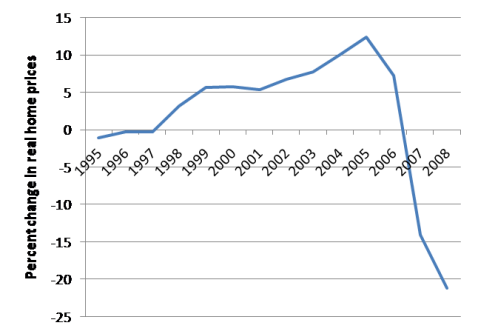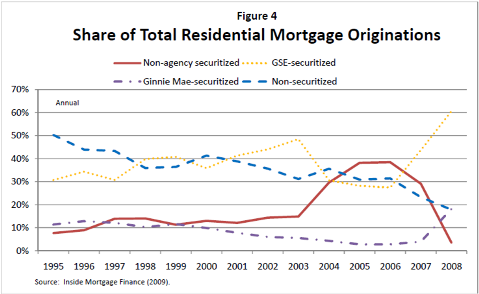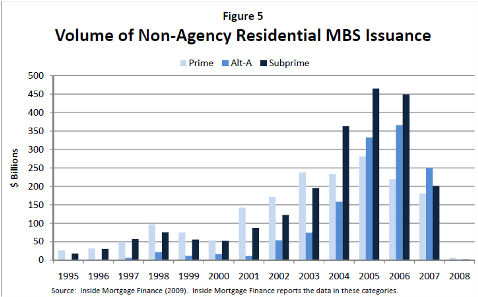By Marshall Auerback, a hedge fund manager and portfolio strategist who writes for New Deal 2.0.
Despite a blame-a-thon on Ireleand, Germans banks are really at the core of the eurozone catastrophe.
Much ink has been spilled in the press over the Irish problem and the laxity of the country’s southern Mediterranean counterparts in contrast to the highly “disciplined” Germans. But perhaps we have to revisit that caricature. Not only has the Irish crisis blown apart the myth of the virtues of fiscal austerity during rapidly declining economic activity, but it has also illustrated that Germany’s bankers were every bit as culpable as their Irish counterparts in helping to stoke the credit bubble.
One of the traditional rationales for the creation of the euro was that a single currency and strict Maastricht criteria would keep the profligate Mediterraneans and their Celtic equivalents in line. Instead, critics, particularly in Germany, increasingly see the European Monetary Union as a means for freeloading nations to offload their liabilities onto fitter neighbors.
Not surprisingly, this has engendered much discussion that perhaps it would serve Germany’s interests to leave the euro, rather than booting one of the Mediterranean “scroungers” out. But as Simon Johnson has pointed out, this comforting narrative of German prudence matched up against Irish profligacy doesn’t really stack up:
German banks in particular lost their composure with regard to lending to Ireland — although British, American, French and Belgian banks were not so far behind. Hypo Real Estate — now taken over by the German government — has what is likely to be the highest exposure to Irish debt.
But look at loans outstanding relative to the size of their domestic economies (using the BIS data on what they call an “ultimate risk basis”).
German banks are owed $139 billion, which is 4.2 percent of German G.D.P. [my emphasis]
Where were the German regulators? As my colleague Bill Black has noted:
They seem to have believed that ‘What happens in Vegas (Dublin) stays in Vegas (Dublin).’ Instead, their German banks came back from their riotous holidays in the PIIGS with BTDs (bank transmitted diseases). The German banks’ regulators continue to let them hide the embarrassing losses they picked up on holiday, but that cover up will collapse if any of the PIIGS default. The PIIGS will default if the EU does not bail them out, so there will be a bail out even though the German taxpayers hate to fund bailouts.
German banks’ relatively high exposure to Ireland does pose the question as to whether there is some wild, Weimar-style hyperinflationista lurking deep in the heart of every German, only able to express itself fully when away from the prying eyes of fellow citizens.
All of the rescue plans that have been introduced in Ireland or Greece thus far rest on the assumption that, with more time, the eurozone’s problem children could get their fiscal houses in order — and Europe could somehow grow its way out of trouble. But the fiscal austerity being offered as the “medicine” is turning out to be worse than the disease. It has exacerbated the downturn and unleashed a horrible debt deflation dynamic in all of the areas where it was reluctantly implemented.
But here’s the thing: these fiscal straitjackets obscure the history of how we came to today’s horrible impasse and, more specifically, the German banks’ role in helping to fuel the credit binge. Also lost is the reason why this has metastasized into a far greater crisis: as part of the eurozone, Ireland does not have the fiscal freedom to come up with a sufficiently robust government response. The UK had a comparable real estate bubble in the late 1980s, which culminated with the Soros attack on the pound in 1992 and the ejection of sterling from Exchange Rate Mechanism (the precursor to the EMU). This was a blessing in disguise. Withdrawal from the ERM saved the UK because it allowed the country sufficient latitude to reflate. Yes, the country had a major recession (in many ways a consequence of the surrender of fiscal freedom as a result of joining the ERM in the first place), but there was never a systemic risk that posed a threat to the country’s overall solvency as is the case in Ireland today. And this is exacerbating the problem in Ireland because it persists in chasing its tail repeatedly with futile fiscal austerity measures.
The truth of the matter is this: the eurozone seems rotten to the core, literally. Germany represents that core. The Germans might occupy the penthouse suite, but it is the suite of a roach motel. And we know what happens to those who enter such “establishments.”
Yes, longer term the problems currently afflicting the eurozone could be sorted via the creation of a supranational fiscal authority — a “United States of Europe”. But with each crisis (Ireland today; Portugal and Spain tomorrow; Italy and then France next?), the political forces are coalescing in a radically different direction. The Germans are becoming increasingly resentful as they perceive their country as the bailout mechanism of last resort (even though the Irish experience suggests that their bankers are also guilty of many of the same excesses as the “Celtic Tiger”). The PIIGS themselves are seeing that the benefits of euro membership have been vastly overstated and in fact now act as a cancerous influence through the Germanic embrace of austerity. (Paradoxically, it has been the “profligate” behavior of those so-called lazy Mediterraneans that has enabled Germany to retain its export-driven model, as well as allowing it to run lower budget deficits than most other countries.)
The eurozone could ultimately end up like Yugoslavia writ large. Prior to the break up of that country, the relatively rich republics, Slovenia and Croatia, resented policies that transferred wealth to the poorer republics like Serbia, Macedonia, Montenegro, or the autonomous region of Kosovo. Once Tito’s organizing genius disappeared, the links stitching the country together became frayed and eventually snapped as old grievances manifested themselves in newer forms. The same could happen to the Europe Union if it underwent a supranational fiscal union — the beginnings of which are already in evidence. I think the Germans are beginning to recognize that, which is why there is discussion about leaving the euro.
But let’s first be clear: German Chancellor Angela Merkel has persistently argued that it is essential that private investors, notably the bond holders, begin to suffer losses so that they will have the proper incentives to provide effective “private market discipline” going forward. She has further argued that it is fair that they suffer losses, given the premium yields they received and their lack of due diligence. That’s an honorable policy. But it’s like the old Irish joke of the driver who gets lost, asks for directions, and is told, “Well, I wouldn’t be starting from here.” By the same token, Ireland clearly illustrates that German banks, as well as their Mediterranean counterparts, would be big losers under the Merkel proposal. Ironically, German financial institutions could find themselves subject to the same kinds of bailouts that Chancellor Merkel and many of her counterparts in Berlin are urging on the Irish and Greeks.
As always, leave it to the Irish to come up with the most poetic response to the crisis. True, W.B. Yeats did not live to see this disaster, but his passionate “September 1913” does evoke the tragedy of today’s Ireland and the futility of the current policy responses for their people (and beyond):
Was it for this the wild geese spread
The grey wing upon every tide;
For this that all that blood was shed,
For this Edward Fitzgerald died,
And Robert Emmet and Wolfe Tone,
All that delirium of the brave?
Romantic Ireland’s dead and gone,
It’s with O’Leary in the grave.
Graves that might soon include not only the O’Learys, but also the Garcias, Texeiras, Moreaus, and Schmidts if a more rational course of action throughout the euro zone is not adopted soon.







